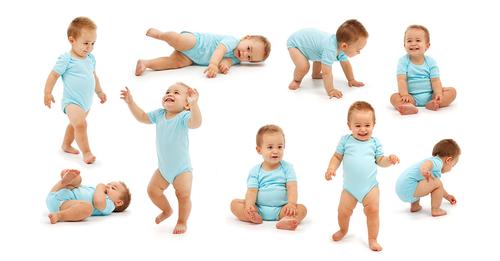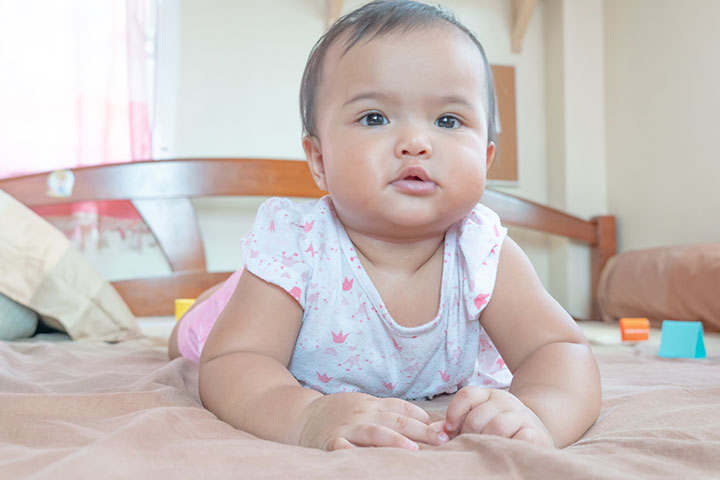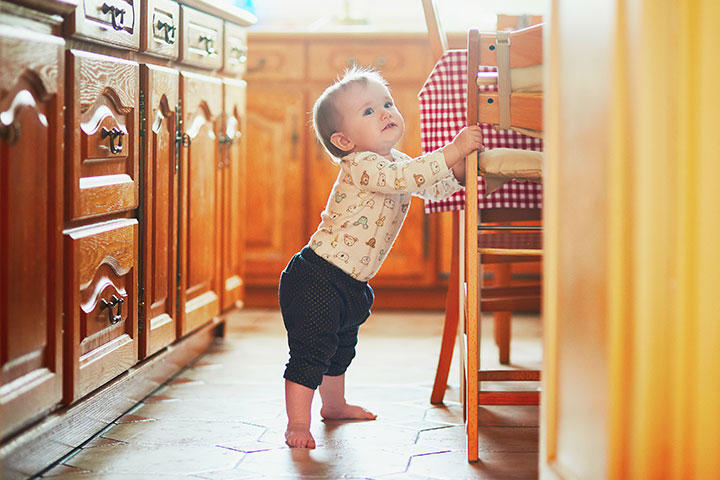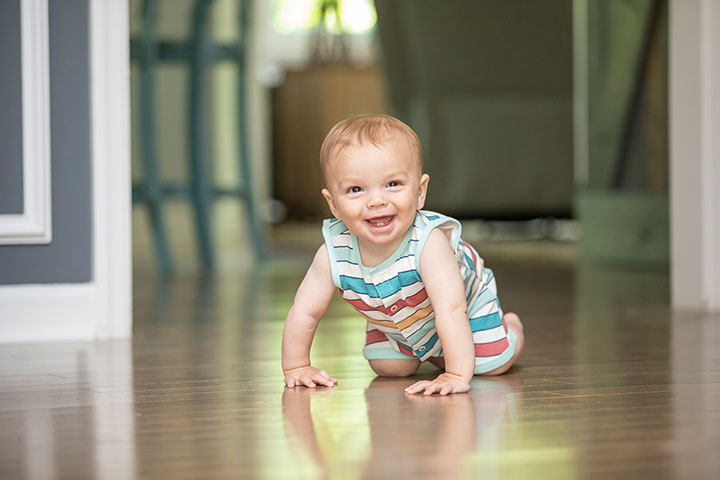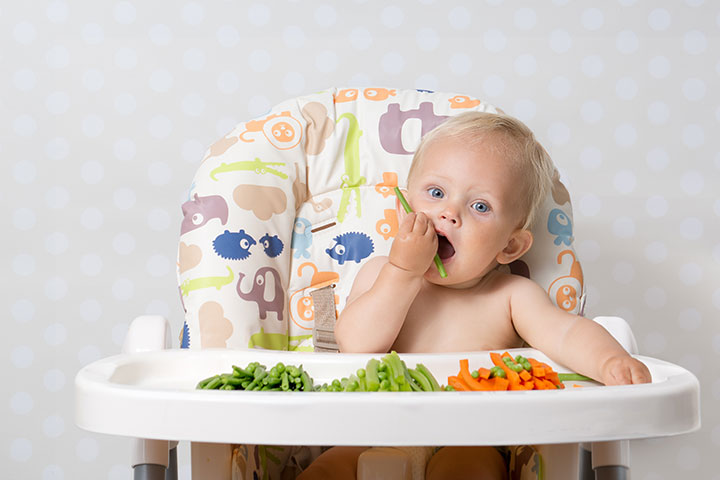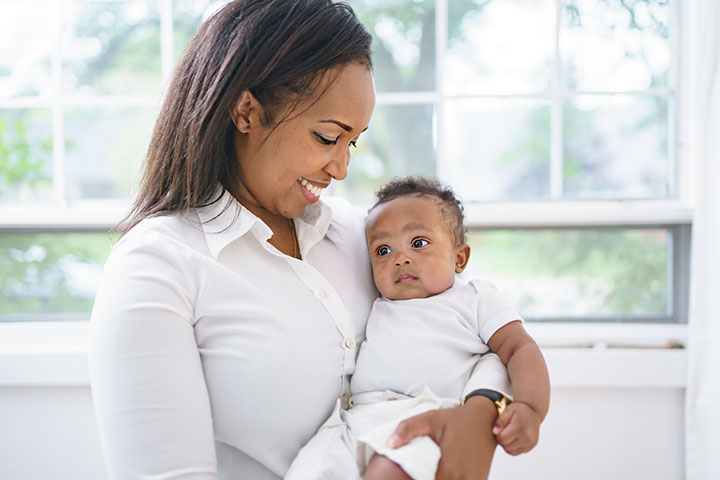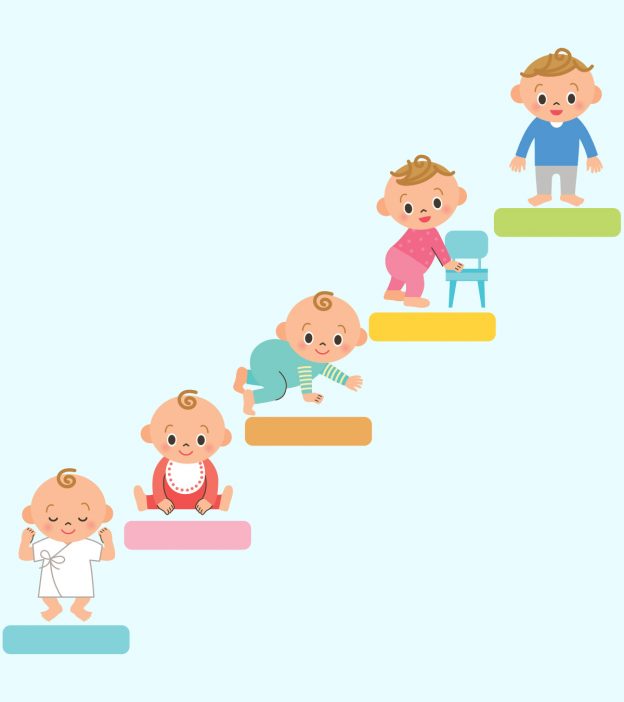
- Did you know that your baby will answer your smile with a smile in just the second month?
- It takes 5 minutes to know about the surprises your baby has in store for you in their first year.
Achieving milestones indicate that your baby’s growth is on the right track. However, starting with social smiling and extending to motor and cognitive developments, a baby’s first year is full of exciting milestones that may bring several surprises. Achieving a stable head, rolling over, crawling, getting their first tooth, and speaking their first words are all examples of a child’s developmental milestones. As a parent, you must track such milestones to rule out disorders your baby may acquire during their growth. We have compiled a list of developmental milestones that babies should ideally achieve by the end of their first year. These are sure to help you understand what may come next and plan things.Be ready for the beautiful surprises your baby keeps giving you.
What Are Baby Milestones?
A baby’s milestones are the essential developmental achievements that signify healthy and timely growth of an infant. Several milestones can be achieved simultaneously.
Developmental milestones are broadly categorized into cognitive, physical, and social and emotional. The most significant and crucial milestones of baby are attained in the first one year.
16 Important Developmental Milestones In The Baby’s First Year
These significant infant developmental milestones in the first year are key indicators of normal growth:
1. Supporting the head:
- At the end of the first month, one of the significant milestones is the infant’s ability to move head from side-to-side when lying on their tummy (1).
- By the end of the second month, babies can lift their heads up to 45 degrees when placed on their tummies (2). Also, the muscles are strong enough to let the baby push his hands downwards when on belly, (3) thus giving the baby more room to see.
- A baby can hold his head steady by the end of the fourth month (4). He can also raise his head to a full 90 degrees when lying on his tummy and has a better head movement control due to stronger neck muscles.
- By six months, the baby has nearly total control of the head and can move it from side to side to see objects and will push the head forward when pulled into a sitting position or raised to be lifted.
- By the end of the seventh month, the baby has smooth and controlled movement of the head.
2. Making sounds:
- By two months, the baby is able to coo and gurgle.
- The baby begins to chuckle, squeal, and chortle at the end of the third month due to the development of the vocal cords, which increases the range of sounds.
- Infants may begin babbling by the end of the fourth month and make single and simple vowel sounds such as “Ah”, “Eh”, “Oh”, etc.
- The sounds increases over the course of two months, and by the end of the sixth month, the baby can string vowel sounds together such “Aaoo” or “Eeaa” (5). They will also make consonant sounds such as “Mh”, “Dh”, and “Bh”.By the end of the eighth month, the baby begins saying “mama” and “dada”, but does not associate a meaning to it and says it to any parent.
- By the end of the ninth month, the baby will attempt to imitate words although his pronunciation would be far from perfect. By 12 months he says “mama” and “dada” to the correct parent, and basic words such as “no” and “go”. He will also say exclamatory words such as “oh” (6).
As the babies lose their birth reflexes, they begin to gain control over their movements. The next five points talk about the various movements your baby learns in the first year. Read on.
3. Rolling over:
- A four-month-old will roll from back to the side and from tummy to the back. The baby would roll only one way.
- By six months, they will roll in two directions from tummy to back and back to tummy.
4. Sitting up:
- From the end of two months, the baby can be held in a sitting position with support. Only at the end of four months can a baby sit properly with support as the neck muscles are strong enough to prevent the neck from having any sudden movements.
- After six months, the baby can sit without support. Once he is nine months old, he can get into a sitting position on his own and also sit for an extended duration of seven to ten minutes.
- On completing ten months, the baby can go from tummy to sitting position, and by the end of the first year, he can sit from standing position.
5. Crawling:
- Babies can lift their head up and push their arms down from the second. The skill improves and becomes the precursor for crawling.
- Babies may start crawling anywhere between seven and nine months. However, most perfect the skill at the end of the ninth month (7). Crawling strengthens the baby’s muscles making them strong enough to stand.
6. Pulling up to stand:
Image: IStock
- A three-month baby will bear partial weight on legs when held in a vertical position.
- At the age of four months, the baby pushes his legs down when placed on a hard surface. At six months, he will bounce on his legs when held vertical with support.
- It is by the end of the ninth month that the baby will pull to stand, using the support of a stationary object, and can also stand at one place.
- By 12 months, the baby can stand by himself without support, but will still pull to stand. However, once in a standing position, he will let go of the support and take a few steps alone thus indicating a significant improvement in his gross motor development.
7. Taking first steps:
Standing leads to walking, and the baby begins walking with support by the end of the eleventh month. This is referred to as cruising.
The baby continues cruising after 12 months. The baby also attempts his first steps alone at this age making it the most significant motor development milestone in the baby’s first year.
Seeing your little one taking his first wobbly steps is a joyous feeling. A mother shares her thoughts on this wonderful moment in her blog post, where she writes, “The days leading up to my baby’s first steps were filled with a mixture of anticipation and excitement. I watched my child pull themselves up, hold onto furniture, and take those wobbly first steps with the support of loving hands. It was as if they were practicing for the big debut. I couldn’t help but marvel at the incredible resilience and determination in such a small package (i).”
 Point to consider
Point to consider8. Smile and laugh:
- You will see the first smile at the age of two months. By three months, the baby smiles at parents and grins at someone who greets him in a friendly manner.
- The baby begins to laugh after completing four months.
- As the baby grows, he will smile and laugh in several situations such as seeing a familiar face, a favorite toy, his feeding bottle, or simply watching someone do something funny. At the end of six months, he will smile at his reflection.
9. Hearing:
- The newborn can hear and hence he calms down when he hear his parents’ voice.
- From the age of two months, babies turn their head towards a source of sound, though it may be in the approximate and not exact direction.
- By the end of the third month, the baby can locate the origin of the sound.
- A six-month-old will develop the ability to not just look at the source of the sound, but also respond to it. This is an advanced baby milestone. By nine months, the baby’s brain can process sounds better, which enables him to imitate sounds and noises that he hears.
- After 12 months, the baby’s hearing skills are well-developed. He can now recognize several unique sounds and identify the voice of familiar people.
 Quick tip
Quick tip10. Vision development:
Image: IStock
- Newborns have a hazy vision at birth, and their eyes cannot focus on an object. Bright colors and high contrast patterns are most likely to grab the newborn’s attention. Objects that are large may also capture their interest(8)
- The baby will look briefly at faces at the end of the first month. Brightly colored objects about three feet away will still interest him (9).
- For the first two months, a baby’s eye balls may not align properly, giving him a cross-eyed appearance. The vision improves by the end of the second month, and the baby can now follow the movement of nearby objects and pay attention to faces.
Lindsey Brooke, a mother of two, records her day with her two-month-old baby daughter. Observing her little one’s actions in the play gym, she notes, “She is very intrigued by all the attachments and she is starting to notice all the colors (ii).”
- By the end of the third month, the baby develops basic hand-eye coordination and better depth perception.
- At four months, the eyes coordinate properly, and facilitate greater depth perception and better three-dimensional vision (10).
- By five months, long-distance vision gets better, and the baby can recognize a familiar face from a distance say across the room. Babies now also respond to familiar faces or objects by chortling and smiling.
- They also have good color vision.
- On crossing the sixth-month landmark, babies visually explore their surroundings. The hand-eye coordination gets better now. At the end of the ninth month, the baby can judge distances accurately. The hand-eye coordination gets better thanks to the newly-developed skill of crawling. It is at this age when the baby enjoys games such as peek-a-boo. By the end of nine months, most babies develop the final color of the eye.
- On the completion of one year, babies see the world exactly like adults do. A 12-month-old can see an array of colors, has strong depth perception, and can track and judge the path of a moving object (11).
11. Night-time sleeping:
- The baby will sleep for an equal number of hours in the day and night for the first couple of months. For instance, infants less than a month, sleep for a total of 16 hours divided equally between day and night (12).
- The daytime sleep decreases by six months and the baby sleeps for only four hours in the day, and eight to nine hours in the night.
- Once the baby is 12 months, his daytime sleep decreases to just three hours, and the night-time sleep increases to a substantial 11 hours.
12. Grasp development:
- Newborns close their fists to grip an object when it strokes their palms. It is referred to as the palmar grasp reflex and is present in the baby right from his birth (13). Babies also have a plantar grasp at birth, where an infant flexes his toes when the sole is stroked. Plantar grasp has no real-world use and disappears after the baby is six months old (14).
- Raking grasp replaces palmar grasp reflex at six months (15). Now the baby can pick an object from a flat surface using all fingers.
- By the end of seven months, the baby uses an inferior pincer grasp, where he will use the pads of the thumb and the index finger for a basic grip on a small object.
- A nine-month-old will develop a complete pincer grasp, where he will use the tip of index finger and the thumb to pick small items from a surface. It is this grasp that helps in the introduction of finger foods.
- By 12 months, the baby has a complex pincer grasp where he can grip objects between the thumb and another finger such as the middle finger.
13. Eating solid food:
- Infants can eat pureed food from the six months as the digestive system is better developed than earlier. A six-month-old can sit with his head straight for an extended period, which are all prerequisites to eating solid foods (16).
- After completing seven months, babies move their jaws to chew food and even close their lips after being fed from a spoon (17).
- At eight months, the baby can bite into hard foods unlike earlier.
- By nine months, the baby can hold food between thumb and index finger. This is the best time to introduce finger foods to the baby.
- The growing infant slowly loosens the gag reflex, which is a natural infantile instinct to cough out solid food chunks to prevent choking. The baby also develops better tongue control, jaw movement, and opens his mouth on seeing a spoonful of food.
- On completing 12 months, the baby can easily eat several finger foods by himself. It is now when you can give the baby foods such as cow’s milk and eggs (18).
14. Teething:
- The first primary teeth to come out are the two central incisors on the lower jaw. The teeth can grow out anytime between seven and eight months.
- The central incisors of the upper jaw are the next to emerge between nine and ten months.
- The lateral incisors of the lower jaw stick out between 11 and 12 months, and the lateral incisors of the upper jaw emerge between 12 and 13 months.
- By the end of the first year, a baby can have a maximum of eight primary teeth, which are two lower-central incisors, two upper-central incisors, two lower-lateral incisors, and two upper-lateral incisors (19).
So, how curious can the babies be in their first year, and how social are they? Let’s know.
15. Cognitive development:
- Babies begin analyzing their surroundings, including objects and people, once they are two months old.
- The major infant cognitive development milestone occurs at the age of four months when the little one experiments with cause and effect (20). The baby tests various actions to observe their outcomes and gauges caregivers’ reactions.
- By six months, the baby develops curiosity towards objects and holds them in his hand to manipulate and interpret them better. It is also the time when babies begin to respond to their name.
- After completing seven months, babies understand the concept of object permanence, where they know that an object does not disappear when it is hidden beneath another object and enjoy activities such as hide & seek.
- An eight-month-old will have a short attention span of no greater than three minutes, but is curious about several things that he sees around him (21).
- A baby starts copying gestures and actions by nine months. It is an important, intellectual milestone for infants in their first year of life. By the end of ten months, the little one is a lot smarter. For instance, if you hide something in front of him he will crawl to unearth the object.
- By 12 months, the baby will have a decent understanding of the names and purpose of several objects around him. He will know that a receiver of a telephone is to be put to the ear and that a comb is to brush the hair. The baby also learns from his parents and caregivers by observing them and learning new skills.
 Quick tip
Quick tip16. Social and emotional development:
Image: IStock
- Newborns show sensory awareness of a familiar person such as a parent. For example, a baby may stop crying when held close by a parent or when he hears the voice of the mother.
- By the end of the second month, they are more aware of their parents and understand that they are the primary caretakers. A two-month-old will smile at other people who interact with him regularly such as grandparents or siblings that babysit him.
- A four-month-old will enjoy simple activities such as playing peek-a-boo with people, smiling at them, responding to affection, and crying differently when hungry, tired, or in pain.
- By six months, the baby remembers familiar faces and will seem uncomfortable around strangers. This is also the age when you will notice unique behavioral traits in your baby. The baby could be shy, irritable, calm, or friendly as per his natural inborn temperament (22).
- At eight months, the baby understands that parents and familiar faces indicate warmth and security. It is due to this that infants develop separation anxiety around nine months and cry profusely when parents go missing from their field of vision (23). By the time a baby is a year old, the baby will show fear especially of something scary or a stranger and will clutch a parent for comfort. A 12-month-old will also resist going into the arms of a stranger. However, he would still go to someone he trusts and reciprocate affection.
Frequently Asked Questions
1. What are the five stages of child development?
The five stages of child development are (23):
- Newborn: They automatically respond to external stimuli (birth to three months)
- Infant: They develop several new abilities (three to 12 months)
- Toddler: They learn to walk, jump, and climb (one to three years)
- Preschool: They can throw a ball, dress, or draw pictures (three to four years)
- School age: They develop relationships and are confident and independent (four to five years)
2. What is the most important age for child development?
Studies show that the first three years after a child’s birth are the most important for their development (24).
3. How do I know if my baby is developing normally?
Some common signs of a baby’s development include (25):
- Regular sleeping and waking pattern
- Development of motor skills, such as sitting, crawling, grabbing toys, and climbing
- Development of verbal skills
- Development of social skills, such as imitating behavior or responding to expressions
- Development of cognitive skills, such as sorting colors
4. When do babies start to understand simple instructions?
Babies can start to understand simple words or instructions around 9 to 12 months of age (26). They may begin to recognize and respond to words like “no” or “where is mummy,” but their understanding will continue to develop over time.
5. At what age do babies start to show signs of stranger anxiety?
Babies start to show signs of stranger anxiety around 8 to 12 months of age. Stranger anxiety is one of the babies’ first emotional milestones (27).
6. How can parents encourage healthy development in the first year?
Parents can encourage healthy development by providing a nurturing environment conducive to the baby’s growth and development. Incorporating physical activities, reading books, talking, and singing to the baby, stimulative and interactive play accompanied by a balanced diet, and proper care can aid proper development.
7. How do I know if my baby is meeting their developmental milestones?
Parents can track age-appropriate developmental milestones, such as sitting up, crawling, and walking, as well as language and social development. Consult a pediatrician if you have concerns regarding your baby’s development.
8. How does a baby’s brain develop during the first year?
A baby’s brain develops rapidly during the first year and doubles in size, with significant growth in neural connections and brain structures. Experiences and interactions with their environment influence this development. Exposure to different stimuli and tasks is critical in establishing neural connections (28).
9. How do babies learn to recognize colors and shapes during their first year?
Babies learn to recognize colors and shapes through repeated exposure and experience. Parents can help by providing toys and objects with contrasting colors and simple shapes for their babies to explore. Books or flashcards depicting colors and shapes can also be used to familiarize children with different colors and shapes.
Milestones in a baby’s first year of life are important indicators of optimal growth and development. Adequate nutrition plays a crucial role in meeting physical milestones, and proper stimulation, interactions, and care can help achieve cognitive and social development. Holding the head, rolling over, sitting up, crawling, waving, walking, making or imitating sounds and gestures, and smiling are major milestones a baby meets in the first year of life. Although slight delays are normal in achieving milestones, it is recommended to seek a pediatric opinion if there is a noticeable delay in development.
